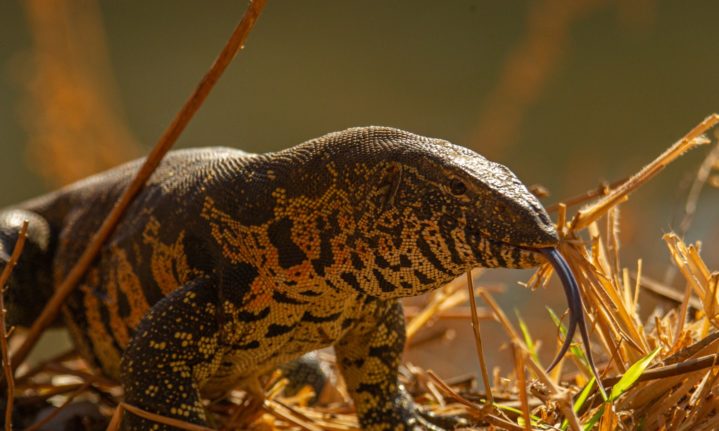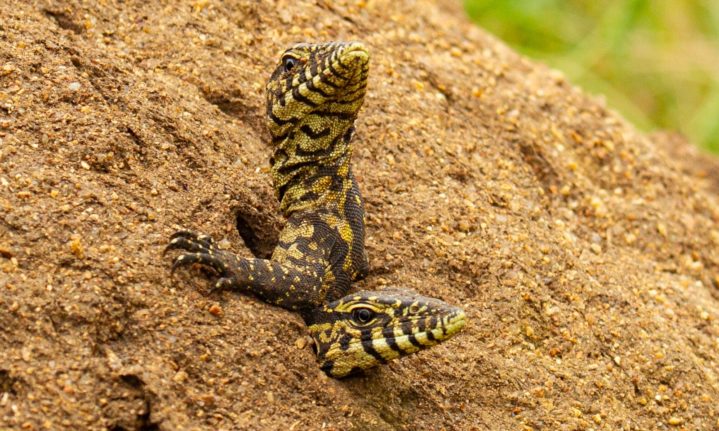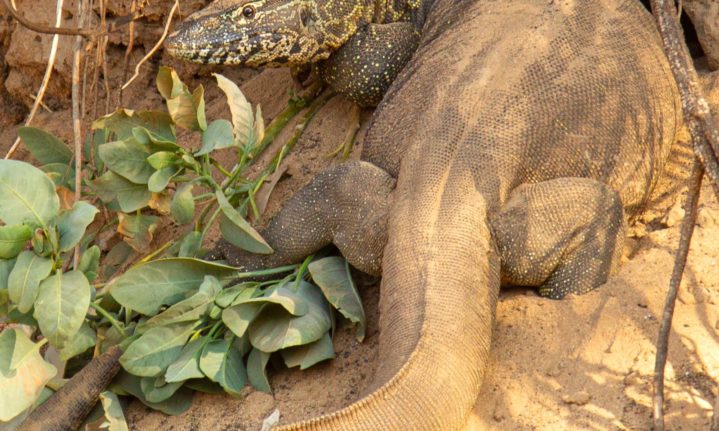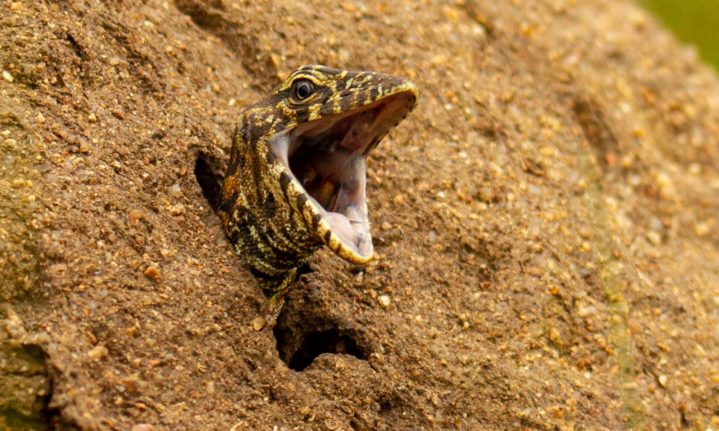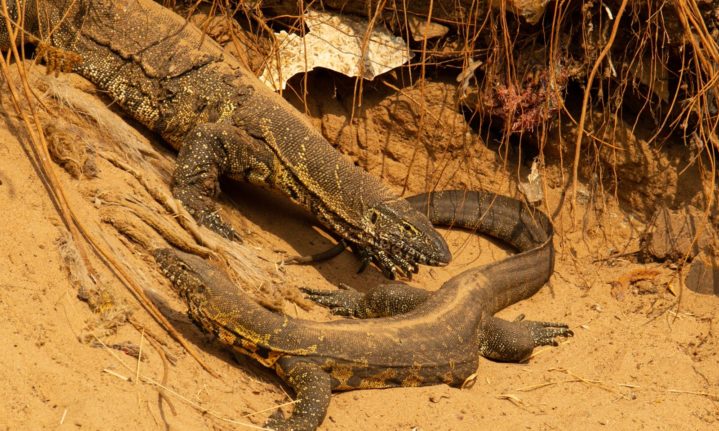With the right kind of care and eco-sensitive attention, even semi-urban residential estates can support incredible wildlife. Conservationist, photographer and budding reptile fundi Ingrid Sellschop watches her baby monitor lizards emerge from their nest.
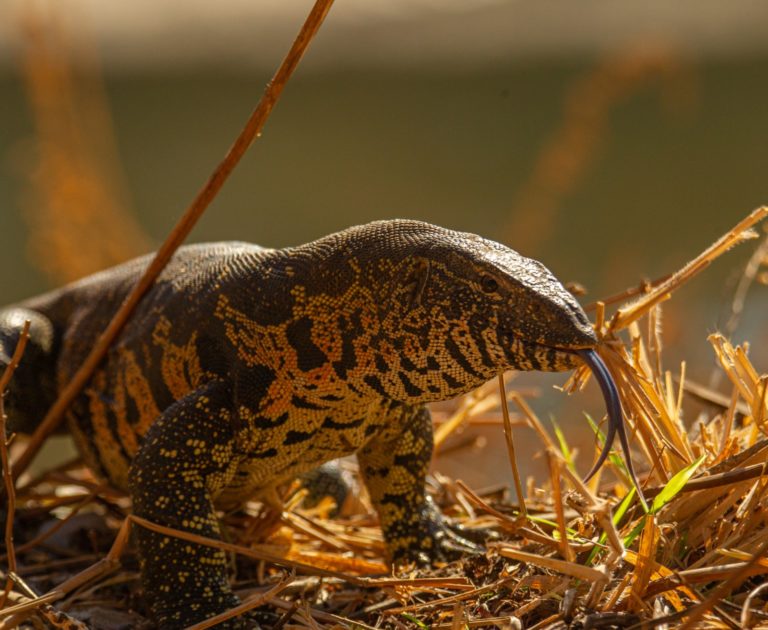
The call came early one January morning. I was on a cross-country run not far from my home base of Waterfall Estate in Midrand. It was Kevin Gow calling. The excitement in his voice was palpable. ‘Ings, your babies are hatching.’
Kevin is a good friend who has, for many years, been involved in the management and conservation of wildlife on Waterfall Residential Estate, a protected, eco-sensitive property on the border of northern Johannesburg and Midrand.
I knew immediately which ‘babies’ he was talking about, and with a renewed spring in my step, I sprinted the last 3km home to collect my cameras and telephoto lens. I’d been waiting for this.
It all started last September while I was taking our dogs for their morning walk. Being an eco-sensitive estate, Waterfall has preserved vast expanses of natural veld grass that is interrupted only by several small dams, a flowing stream and a network of pathways.
It was on one of these pathways on that morning walk that I first encountered her: the large female Nile monitor. Near a dam on the estate, the matronly reptile was so busy digging her way into a large termite mound to make a nest that she didn’t even seem to notice either me or the dogs. Fortunately, Roxy and Benji made it clear that reptiles were not high on their list of canine curiosities at that hour of the morning and obediently lay down next to me while I sat, entranced by this astonishing sighting.
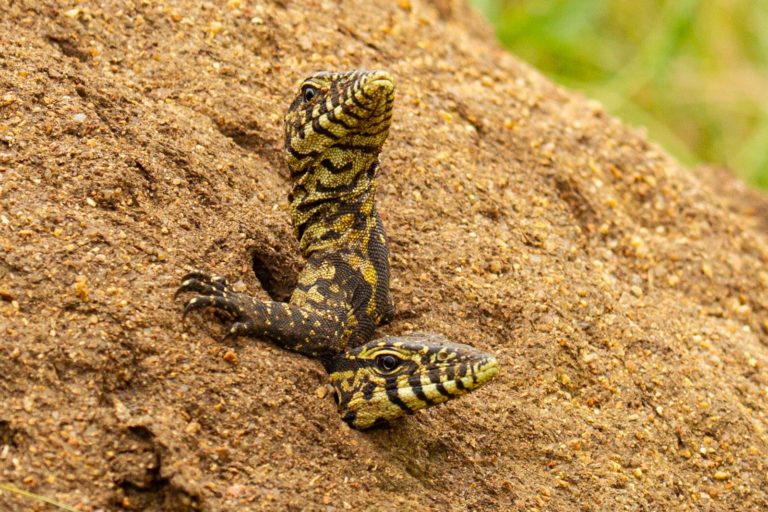
I watched as she progressed with her determined digging. Nile monitors (Varanus niloticus) are oviparous and commonly excavate active termite mounds in which to lay their clutch of eggs. Diligently the large nails on her front feet tore at the hardened earth, slowly carving open a passageway to the dark interior where she would lay her eggs.
I did not need more of an invitation to stake out the site with my camera and a 400mm telephoto lens. She deposited her clutch of eggs over a period of two days, sleeping in the termite mound at night and emerging on the morning of the third day. I had shared the details of the sighting with Kevin, himself a keen amateur herpetologist who knows plenty about reptiles. Together we kept an eye on the termite mound for four and a half months until, finally, I got that call.
Kevin just happened to be in the vicinity of the termite mound that morning; he noticed several monitor hatchlings emerge from a small opening in the dark interior of their natural incubator. They appeared slowly, tentatively sniffing the air as they embarked on their first explorations of the bright world outside their nest. Given my excitement, it did not take me long to join Kevin at a spot from where we could watch the performance without intruding into their space. From that discreet distance my telephoto lens allowed me to record a rare moment.
Existing literature on the breeding cycle of Nile monitors pitches the incubation period of the eggs at somewhere between 180 and 270 days, depending on the nature of the nest, the ambient climatic conditions and, of course, fluctuations in seasonal temperatures.
As far as I know, what we were seeing has not generally been documented in the wild, so we were privileged to be witnesses. It also enabled us to establish a precise incubation timeline for Nile monitors living in the wild on the Highveld.
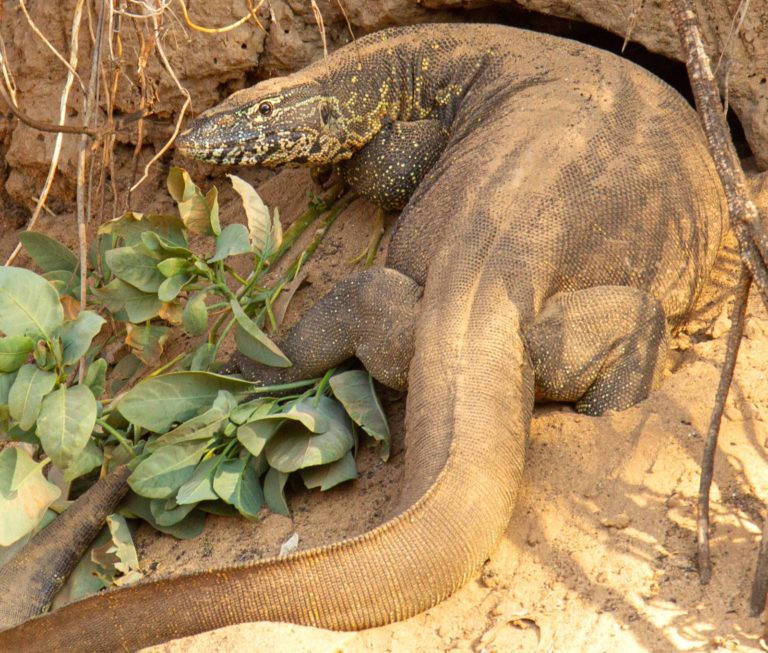
Nile monitors are Africa’s largest and most iconic lizards. Native to the continent, they’re distributed throughout central and southern Africa, including Sudan and a portion of central Egypt along the Nile River. They occur in a wide variety of habitats wherever there are permanent bodies of water. They can reach lengths of between 1.5m and 2.4m, bearing a strong resemblance to their much larger cousins, Komodo dragons, which are found on an island off the Indonesian coast.
Nile monitors are not threatened per se but are under pressure from expanding urbanisation and the increasing development of human settlements. A more sinister threat to their survival is the belief among many indigenous cultures that their skins and body fat hold medicinal properties. Consequently, they are hunted and sold as part of the muthi traditional medicine trade.
They are therefore a protected species – keeping, selling or killing a Nile monitor is illegal in South Africa. But as the illicit trade in primates, pangolins and rhino horn has already demonstrated, money speaks far more loudly than the law in developing societies.
In an increasingly challenging environment, Nile monitors breed only once a year, with the season generally starting in June and ending in October. After the spring rains, the female excavates a hole in the ground (or in an active termite mound). There she lays between 40 and 60 eggs. The termites, for whom temperature regulation is imperative (their fungus survives in a very narrow temperature range), immediately set about repairing the hole in their nest once the monitor has laid her eggs and left.
In conditions of fairly constant temperature and humidity ranges, the unattended eggs incubate over a period of six to nine months before the hatchlings emerge from their shells. Interestingly, the lizards at Waterfall Estate hatched after only four months.
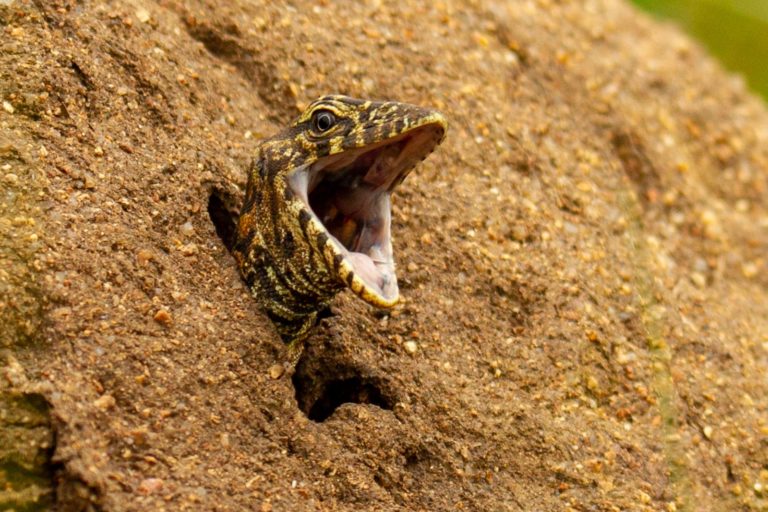
The hatchlings are approximately 30cm long and weigh about 26g each. Once out of its shell, the monitor will dig its way out of the termite mound and begin to address the challenges of growth and survival in its new environment. They are precocial, meaning they’re independent of their parents for feeding. Waterfall Estate has a natural abundance of food suitable for Nile monitors. While they eat principally riverine crustaceans – small fish, frogs and birds – they are particularly fond of zebra agate snails which breed prolifically on the estate. This means they should be happy here.
Upon emerging from the small excavated hole in the termite mound, the hatchlings – cute and vulnerable – pushed and squeezed their way over each other to survey the big world outside. A few seemed nervous and tried to scurry back into their place of safety, pushing into the other hatchlings and trying to get a peak of the outside world.
Once they had the full length of their slender little bodies outside their exit hole, they very quickly climbed up and over the termite mound and slithered off into the long grass. One hatchling clambered over Kevin’s arm as he lay poised in the grass with his camera ready to shoot.
I’ve since had a chance to observe the banks of the small river that runs through our estate and noticed an abundance of monitor burrows that are used by these shy, benign reptiles during their breeding season. We’re lucky to have them – their survival here is due to the fact that the estate is situated on what was once a large open space of Egoli grassland incorporating an extensive series of drainage lines.
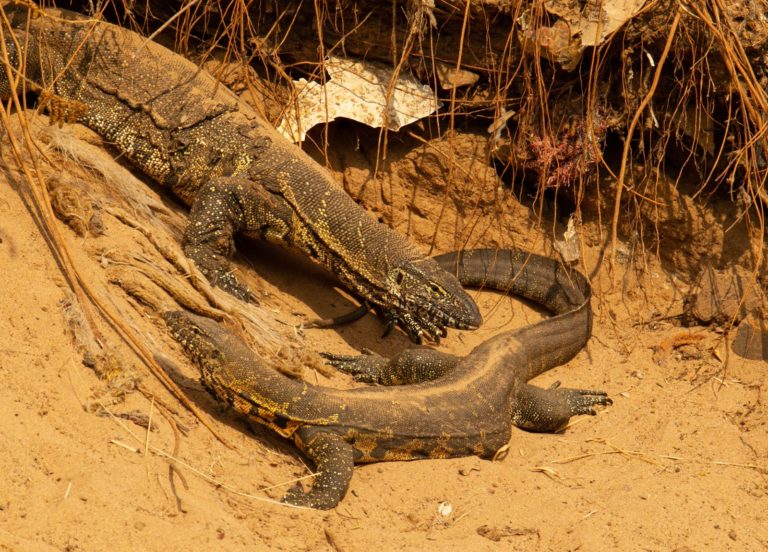
This terrain provides an ecologically protective and significant corridor of rich wetlands with several moist grasslands that are suitable for the survival of the indigenous flora and fauna remaining within the estate boundaries. The numerous termite mounds, which provide an essential breeding ground for the lizards, have mercifully been protected by the estate’s management team.
In the time since we observed the babies being hatched, I’ve seen a few adult monitors soaking up the sun at the dam close to that termite mound. I am often on the lookout on my morning walk, ever hopeful for a sighting of one of the large male breeding monitors basking outside their burrows on the banks of the Jukskei River that runs through the estate.
6 curious cold-blooded critters
Legless burrowing skink
Not to be confused with a snake, this critically endangered lizard (yes, lizard) evolved to lose its legs because, well, it no longer needed them. Also called the Durban dwarf burrowing skink, it’s usually found in KwaZulu-Natal and Mozambique
Geometric tortoise
This critically endangered species has lost 90% of its habitat in the Western Cape to vineyards and urban development. It is petite, only reaching a length of 15cm. Its distinctive black shell with its bright yellow starred geometric patterns make it the most endearing of tortoises.
Armadillo girdled lizard
Getting its name from the way it curls up in defence, similar to an armadillo, these lizards are endemic to the mountains and rocky outcrops of the succulent Karoo. Their popularity as exotic pets is a growing threat.
Albany adder
One of the world’s rarest snakes, with only 17 recorded observations in the wild, Albany adders are endemic to the succulent thickets of Algoa Bay. They only grow to 25cm in length.
Yellow-bellied sea snake
The most widely distributed sea snake in the world, these beasts have been recorded along South Africa’s southern and eastern shores. An accomplished diver, it can dive deeper than 50m and remain submerged for more than three hours. It is a highly venomous snake – half a teaspoon of venom is thought to be enough to kill a human – but is not known to be aggressive.
Namib sand gecko
This small gecko is endemic to the Namib Desert. It is almost translucent and is perfectly camouflaged for its surroundings. Interestingly, it has webbed feet, which allows it to burrow into the sand or move across the loose Namib Desert sand.
A version of this article appeared in the August 2022 print issue of Getaway
By Ingrid Sellschop and David Henning. Photographs: Ingrid Sellschop
ALSO READ: Matabele ants’ epic egg-carrying parade
Follow us on social media for more travel news, inspiration, and guides. You can also tag us to be featured.
TikTok | Instagram | Facebook | Twitter









